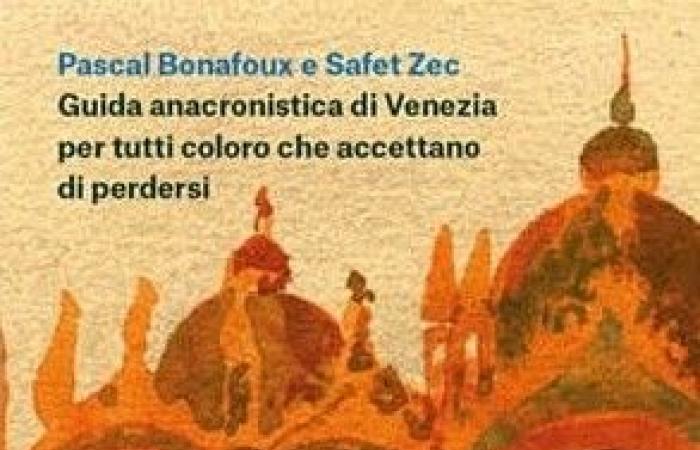Prof. dr. Aida Abadžić Hodžićauthor of the introductory essay to the volume, presents Workshop And Pascal Bonafoux there Anachronistic guide to Venice in the presence of the artist and the publishers. Bro intervenes. Linen Breda.
The presentation – open to all while places last – is opened by greetings from Enrico Mazzoccodirector of Hotel Monaco and of Marco VidalCEO The Merchant of Venice
At the end of the presentation, a 10-minute excerpt from the documentary film about Safet Zec “The Masters’ Path”, directed by Gorčin Zec, will be previewed and will premiere at the Sarajevo Film Festival, 16-23 August 2024.
The volumes:
Safet Zec. Workshop
Qupé editions, 2024
With an essay by Prof. dr. Aida Abadžić Hodžić
French, English and Italian text and two hundred images including works and photographs by Safet Zec in his studio in Venice
On the other walls of the Venetian studio, older works hang: paintings of treetops, boats, house facades, people praying… Every now and then Safet passes by and adds a few brush strokes. As if he were conversing with them. On the central wall, large, formats several meters high, other paintings on which he works – writes Aida Abadžić Hodžić in her essay entitled “The ateliers” of Safet Zec. Aida Abadžić Hodžić, Sarajevo art historian and critic with professorship at the University of Sarajevo, has followed the artist for many years with his essays and now helps us enter and reconstruct the spaces of Safet Zec, touch their essence , finding the common thread that unites them… The first studio in Belgrade in the Seventies, the falling in love with Počitelj, the returns to Sarajevo, the new beginnings in Udine and the decision to settle in Venice in 1998. The iconography for the book it is selected from a vast archive of photographs of Safet Zec’s studio in San Francesco della Vigna in Venice, a space where he worked for a long period, from 2006 to 2023. The studio in Venice is the romantic goal of a mature painter. In the Venetian studio, Safet’s painting reached the universal power of artistic language – writes Aida Abadžić Hodžić again. The book collects photographs of the artist in his daily life, of the works in the different stages of creation and reproductions of finished works. Four recent large works are reproduced for the first time in a book: the altarpiece for the Treviso Cathedral (2019) and the three works for the church of San Teonisto (2023) by the Benetton Studi Ricerche Foundation, always in Treviso. In addition to the photographs from Safet Zec’s archive, shots taken by him or by his children, the book naturally also includes works by photographers who knew the artist, portraying in particular the studio at the Vigna and the works present: Francesco Allegretto, Marc De Tollenaere, Velija Hasanbegović, Veronica Mecchia… The book could not miss the testimony of Safet Zec’s participation in the 60th International Art Exhibition, the Venice Biennale. Inside the beautiful Venice Pavilion there are ten recent paintings from the “Prayer”, “Abbracci” and “Exodus” cycles, a large “Mother with Child” canvas (finished painting on site) and an atelier, rebuilt by the artist in one of the spaces with another twenty-five works on display. Safet Zec at the Venice Pavilion is the long-awaited occasion for the release of the book Atelier.
The book Safet Zec. Atelier is an editorial project by Hana Zec and Federico Fazzi, editors and founders of Qupé éditions, a publishing house based in Paris. Workshop is the tenth book by artist Safet Zec published by Qupé.
Pascal Bonafoux and Safet Zec, Anachronistic guide for all those who accept getting lost
Qupé editions, 2024
Written by Pascal Bonafoux with thirty-six works by Safet Zec
There Anachronistic guide to Venice it is the first book translated into Italian. Also available in French
No glance can completely capture Venice, writes Héctor Bianciotti in one of the many quotes scattered throughout this book. But then how to deal with the city that more than any other risks “falling from cliché to cliché”? There is a solution: getting lost. In this singular Guide, Pascal Bonafoux renounces any ambition to catalogue, organise, systematise the infinite identities of Venice and instead chooses to abandon himself to them – or almost. In fact, Bonafoux is guided by the many traces that Venice has left in art and literature: Proust, De Musset, Rilke, Chateaubriand, Gautier, Casanova… thus, step by step, the author composes a sort of chaotic Venetian anthology and unpredictable, anachronistic like the city and at the same time useful for grasping the refractions that reach us from the past. But the Venice of this book is not just made up of letters. The paintings and drawings of Safet Zec, the author’s friend and traveling companion, reflect a parallel intent: to discover Venice one detail at a time, leaving aside the general picture and accepting to get lost in an infinity of details, apparently negligible subjects and instead, precisely for this reason they are revealing. Because only those who get lost can truly see – and this is, perhaps, what Venice still has to teach us
The artist
Safet Zec Painter and engraver, he was born in 1943 in Rogatica, Bosnia and Herzegovina. He is considered one of the most important figurative artists in Europe. He graduated from the Higher School of Applied Arts in Sarajevo and the Academy of Figurative Arts in Belgrade. At the beginning of the war in Bosnia and Herzegovina he moved to Italy and has had his studio in Venice since 1998. Today he lives and works between Sarajevo, Počitelj and Venice. Books and catalogs of the artist published by Qupé éditions: Anachronistic Guide to Venice, Abbracci/Embraces, Exodus, Carnets, La peinture et la vie, Traveling with Safet Zec, Ceramolle, Deposition, Safet Zec monograph.
Aida Abadžić Hodžić she is an art historian and critic. She is a professor of art history at the Faculty of Philosophy in Sarajevo. You founded and directed the first Bosnian magazine in the field of contemporary visual arts, art criticism and theory, Vizura. She is the author of important art monographs and numerous exhibition projects in the country and abroad, among others at the Palais UNESCO in Paris, the Correr Museum in Venice, the Pera Museum in Istanbul, and the Art Pavilion in Zagreb.
Linen Breda, monk and biblical scholar, was a student of the art historians Rodolfo Pallucchini and Alessandro Ballarin. Graduated in Pharmacy in Padua and then graduated in Biblical and Oriental Sciences in Jerusalem, he is an expert in ecumenism and Orthodox spirituality.
Pascal Bonafoux, writer, critic and art historian, has curated several modern and contemporary art exhibitions around the world. Professor emeritus of art history, he is the author of numerous studies mainly dedicated to self-portraiture in Western painting. Among the exhibitions he curated, «Moi! Self-portraits of the 20th century» held first at the Musée du Luxembourg in Paris and then at the Uffizi Gallery in Florence. Books by the author published by Qupé éditions: Declaration of love in paint, Trajectoire incalculable – dictionnaire des métaphores par Victor Hugo, Carnets de Safet Zecmonograph Safet Zec.
Cini shop is located in San Vio in front of Palazzo Cini in Venice. It is a concept store born in 2020 from the common will of Vittorio Cini Archive Foundation and of The Merchant of Venice to promote the centuries-old Venetian tradition of artisanal production he was born in trade of refined artistic and consumer goods and high quality services (from books to glass, perfume, objects and merchandising). Today Cini shop it is the home of Venetian excellence in craftsmanship, but it is also an art gallery that permanently hosts the artist Safet Zec.
In its commercial space it combines the Venetian perfumery art of The Merchant of Venice with other local excellences, such as the Impiraressa Marisa Convento, resident artisan, the NasonMoretti glassworks, selected publishing houses, the ancient artisan paper mill Toscolano 1381, the silk-screen prints of Gianpaolo Fallani, the handmade Eat&Run candles, the precious silk bags by Bevilacqua.
Hotel Monaco & Grand Canallocated in one of the most exceptional positions in Venice, where the Grand Canal overlooks the San Marco basin, includes various buildings including Palazzo Dandolo, inside which are the Salt of the Ridotto. These rooms, immortalized in the famous painting “Il Ridotto” by Francesco Guardi (1745-1750) now preserved in Ca’ Rezzonico, played an important role in the history of the Serenissima. From the seat of the French embassy in the sixteenth century, in the eighteenth century they hosted a gambling house managed directly by the state and open to all (“publico reduced”) and, having acquired considerable fame, they became an obligatory stop for travelers on the Grand Tour. The gambling house, closed for reasons of public order in 1774, was later used as a theater and in times recent part of the Hotel Monaco & Grand Canal hotel complex.
Today, after restoration interventions carried out with the utmost respect to preserve and conserve the authenticity of the premises, the spaces accommodate a fully frescoed multipurpose roomsurrounded by eight further smaller rooms, which are well suited to hosting any type of corporate event, from an incentive to a convention, from a fashion show to an exhibition or a workshop.






